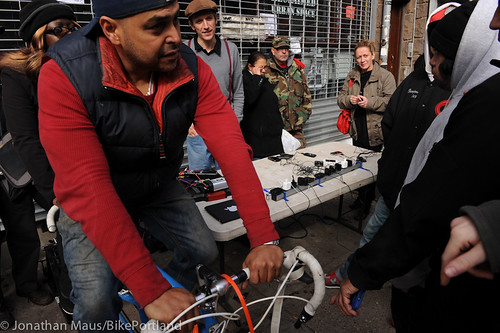
(Photos © J. Maus/BikePortland)
made possible by:
- Planet Bike
- Lancaster Engineering
- Readers like you!
While scenes of distress are beginning to show in some parts of New York City (lines for gas, chaotic traffic, fights at bus stations, empty food store shelves), there are also signs of hope. And bike activists are behind many of them. From organized programs deployed by advocacy groups; to citizen volunteers armed with bikes, the power of the Internet and big hearts — two-wheeled aid is going strong here.
Down on the Lower East Side, volunteers with Times Up are making a lot of friends with their free bike energy charging station. Set up at 10th and Avenue C, in front of a building known as “C-Squat” whose ground floor will soon open as the Museum of Reclaimed Urban Space (MORUS), the charging station has quickly become a magnet for East Village residents. Flyers posted around the blocks announce “Free Cell Phone Charging and Food” and word has quickly spread through the neighborhood.
George Pingeon is a Times Up volunteer who has made a name for himself for his ability to harness pedal power into electricity. A bike tour guide by day, one of his accomplishments is the Energy Bike Project, a fleet of 14 custom fabricated bike stands that helped power the Occupy Wall Street movement. Now he’s putting them to use on a sidewalk in the East Village that was submerged under five feet of water just a few days ago (I saw the proof via cell phone images shared by a guy named Tony who wanted to know which news outlet might buy them from him). People in this part of town still have no electricity, no running water, and food is in short supply.
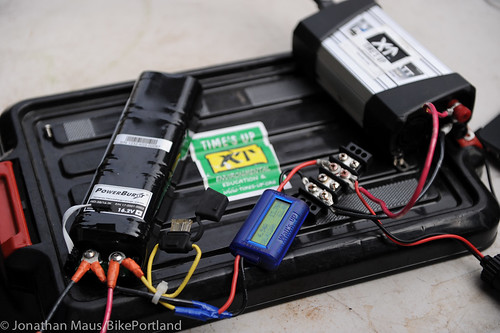
Even before Pingeon got set up this morning, people were eager for it to get working: “Are you guys doing the bike charging thing again?” “Are you in line?” “Who’s first in line?”. As the energy station got set up, Herson Cabreras and a group of friends walked up. “How did you do this? We need these down on East Broadway! There’s a church… People are walking around all crazy. We’ve got bikes; but there’s nothing down there.” he kept saying.
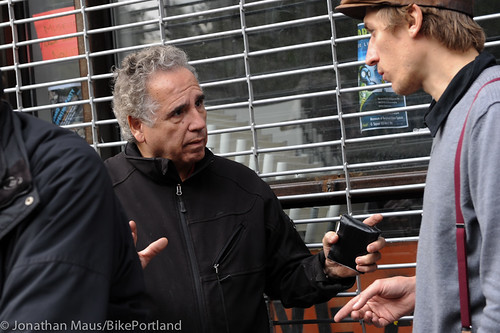
Cabreras said people were wandering the streets looking for power and he was intent on either buying a bike generator system or making one himself. Once he realized they weren’t for sale, he whipped out a paper and pen and started peppering Pingeon with questions. “Is that your inverter? Because I’ve got one of those already. What else do I need? Where I can buy this stuff.” Pingeon patiently and clearly explained how the system worked and I have no doubt Mr. Cabreras is busy putting one together as I type this.
Once the system was up and running, people from the neighborhood stepped up onto Pingeon’s Burley tandem and started pedaling. The relief of being able to power up their phones, combined with the endorphins and camaraderie brought on by the physical activity, quickly produced smiles on the riders and the spirit on the sidewalk lifted. When I stopped by the station last night, C-Squat resident Bill Cashman said people from the neighborhood never stopped to talk with him or anyone that lives in his building. But Sandy changed that. “It was an island before,” said Cashman, about his building. This morning, those same people filled the sidewalk and everyone chatted as the phones got charged. “It’s awesome,” he added, “we’re getting to meet our neighbors.”
Times Up isn’t just creating power by bike, they’re creating community.
Check out this short video I made of the energy bikes in action (learn how the energy bikes work at Times-Up.org).
A few blocks south, the Recycle A Bicycle shop is open for business. Employees Patrick Tomemy and Brendan Brogan stand on the porch, offering to help anyone who needs it. Their showroom is dark; but they’re helping out a steady stream of customers. They sell used bikes, so the price is right for folks just looking for anything to get around (there’s still no subway service in Lower Manhattan). One guy who picked up a nice, geared cruiser, stopped to look at the bike before pedaling off and exclaimed, “I got a bike! I got a bike! This walking is killing me!”
Inside, Tomemy helped a customer install a new saddle on a man’s bike that had been stolen the night before. Using a flashlight, he ventured into the back of the store and emerged with the new seat. Before I left, Tomemy had one request of me. “If you see any other shops open down here, please call us and let us know. We are running out of stuff and want to tell people where else they can go.”
Advocacy group Transportation Alternatives is also making it easier to cope for people on bikes. Each morning since Sandy they’ve set up bike commuter help stations on the bridges, offering free coffee, advice, and moral support. The storm has brought out a lot of first-time riders, so helping make their ride as enjoyable as possible is the goal. Tomorrow they’ll set up a commuter info station in Times Square.
TA and other citizen activists are also organizing bike trains from shops throughout the city. These trains offered guided rides and the safety of riding in a group. I joined one from Brooklyn into Manhattan this morning and will share that experience in a separate post.
Bike-loving New Yorkers are also using the web to make riding as easy as possible. The #bikenyc hashtag on Twitter is full of help and advice from a variety of sources. Volunteer Kim Burgas has swung into action quickly to create a new website, Bikeapolis.us where she’s collecting resources and information.
And sometimes it’s just individuals who are using their bikes to help others. I met one gentleman on the Manhattan Bridge who had an Xtracycle bin full of vegetables. He was carting them around to those in need.
The post-Sandy recovery is not easy on those who live here. Some areas are expected to be without power through the end of next week. There are gigantic trees still toppled over in many neighborhoods, the flooding damage is far from being fixed, the air is getting colder, and tempers and supplies are getting shorter. Yet against that backdrop, It’s been amazing to see how the bicycle has performed so valiantly; both in getting people where they need to go, and in bringing people what they need. It’s the only vehicle I can think of that offers efficiency, resilience, and hope.
— This post is part of my ongoing New York City coverage. I’m here for a week to cover the NACTO Designing Cities conference and the city’s bike culture in general. This special reporting trip was made possible by Planet Bike, Lancaster Engineering, and by readers like you. Thank you! You can find all my New York City coverage here.


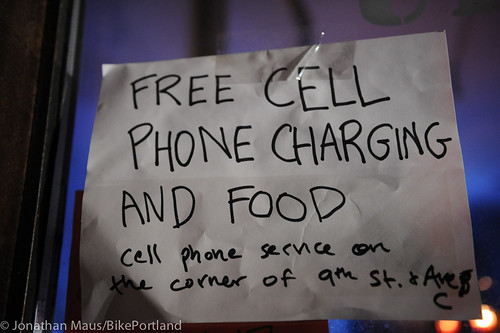
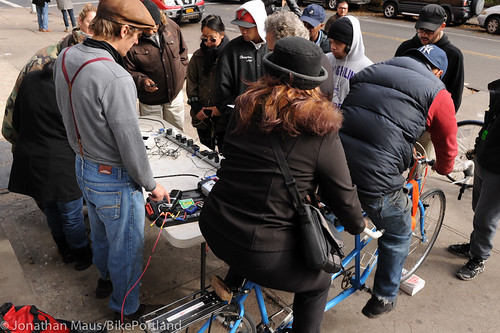


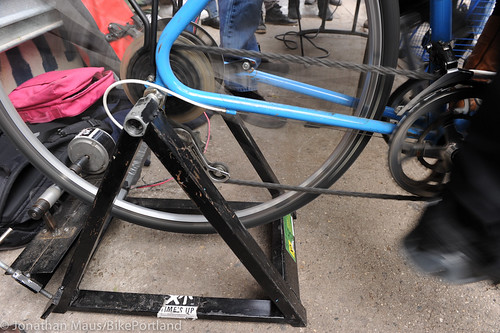
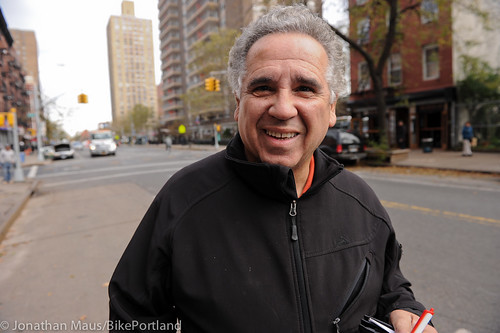
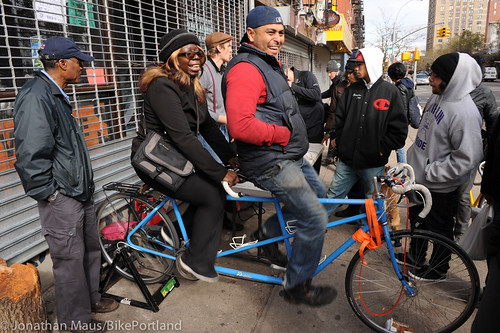
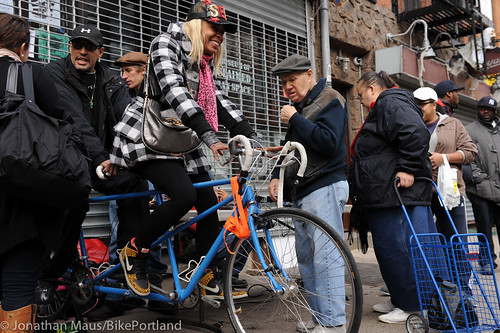
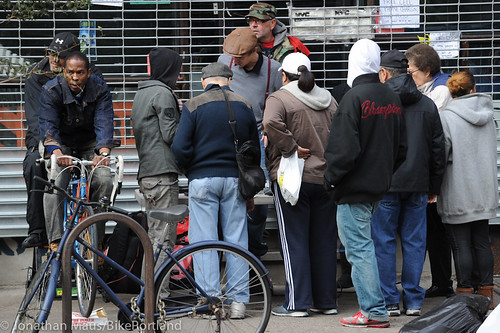

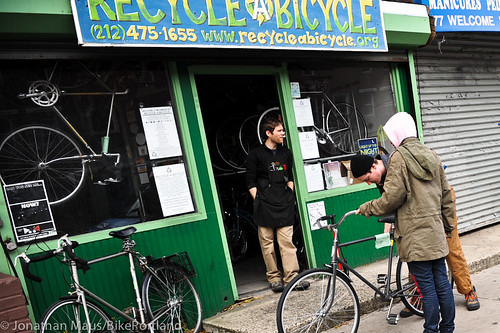
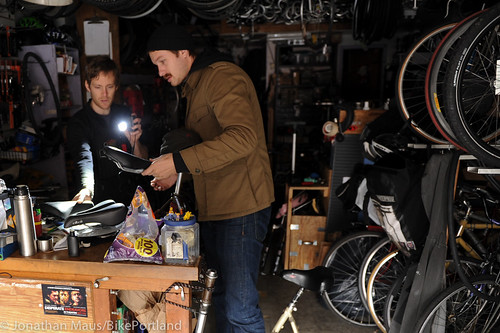
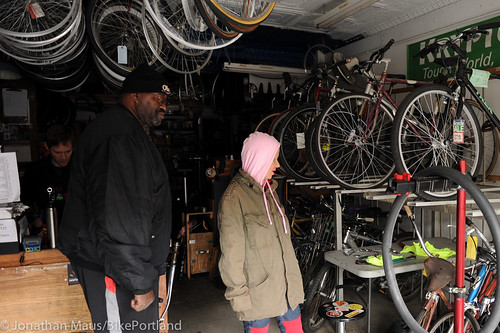
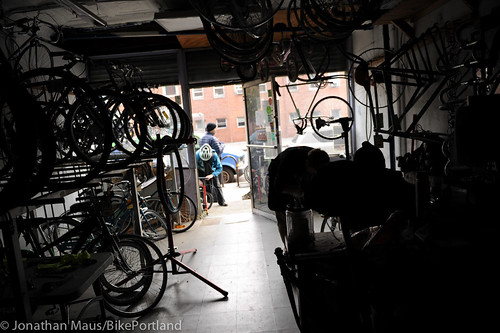
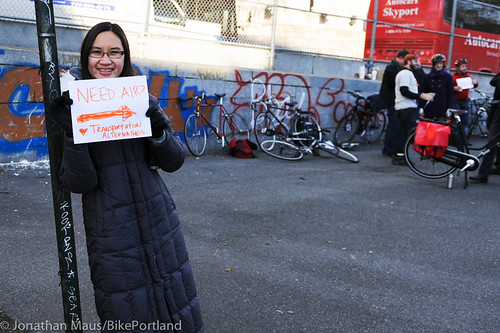
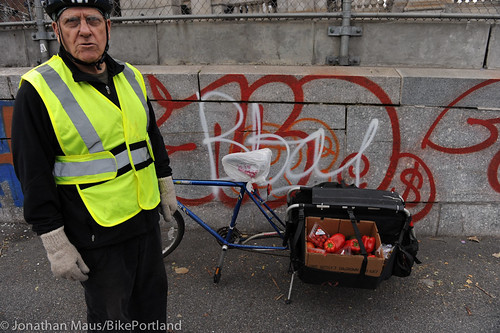



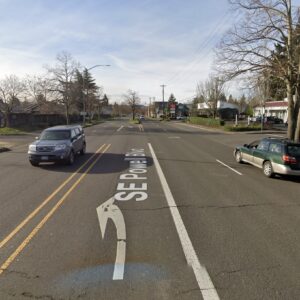
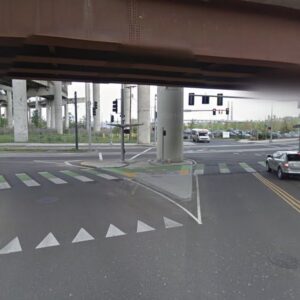
Thanks for reading.
BikePortland has served this community with independent community journalism since 2005. We rely on subscriptions from readers like you to survive. Your financial support is vital in keeping this valuable resource alive and well.
Please subscribe today to strengthen and expand our work.
I am officially inviting some NYC cargobike riders to come west for the 2013 Disaster Relief Trials. By the time this is over they will be able to teach us a few things.
Yeah, that would be awesome. Just think, you are in a sticky situation and need help. Here comes some dude on a bike. Good luck with that one. If you stay in your own little world you may be the most helpful person known to man but to those in need you continue to be a tool
I wonder how many phones can charge at the same time by one person powering a bike? Two, three, more? Anybody know? Cool story, thanks so much for the great coverage Jonathan.
Hi Gary,
I think at least a dozen devices can be charged at once. There’s a ton of info on how it works on the Times-Up website.
With a fair amount of effort an average person can generate 25 watts for an extended period of time. The standard USB charge rate is 0.5 watts, so (50) phones?
The people on that tandem were riding at a 15 watt/hour pace… which was the limit of the inverter he was using.
Thanks for writing up this great piece Jonathan – just correcting some of the numbers for your readers. The average tandem riders were outputting approx. 80 Watts at a moderate pace, but at any point we were putting out 100+ Watts over the course of the day, charging 20+ phones. Later in the day, we hooked up the belt drive generator, and used the tandem for a sprinting exercise running a 250W pump to unwater the basement. A pair of strong riders could keep the pump running for about a minute and a half, before the voltage dropped too low, slowly charge the ultracapacitor back up to 15V for about 45 seconds, then sprint again. Over the course of the day, approx. 12-6pm, two bike generators produced over 1,000 WattHours of power.
Thanks for swinging by Recycle-A-Bicycle, Jonathan!
I got their newsletter today and they said that they’re doing pretty well, although they did have a flood and an electrical fire in one of their locations.
Also in their newsletter they linked to this Bloomberg news story: http://go.bloomberg.com/hurricane-sandy/2012/10/31/advice-for-post-sandy-new-york-traffic-take-the-bike/
Recycle-A-Bicycle and the Community Cycling Center are similar organizations and we are relieved that they are OK.
That is SO cool seeing how people are coming together after the storm, and how bikes are doing so much to facilitate it.
Great Reporting Jonathan!
Wonderful write-up. It’s great to see #bikenyc from another perspective– before Sandy and now. Glad to see that you made it to one of the Brooklyn biketrains this morning, Jonathan.
For any new #bikenyc commuters who might be reading, you can get the latest updates on new biketrains by following @NYCbiketrain on Twitter or the NYC Biketrain Facebook page, and details to follow on bikeapolis.us
I love this story. I am motivated to make a trailer, and generator. Why to go with the stories and the reporting !
Way to go.
“people were wandering the streets looking for power”
This is what dependence looks like.
Once upon a time people would have been looking for other things… food, water, blankets. Now they may still need those things, but we’ve added kilowatt hours to the list.
Very inspiring, Jonathan. Are you still in NYC, then?
Jeez. Talk about throwing rocks in after somebody fell in a well. I bet if the people of NY could inform their family of their well being via smoke signals they would.
And realistically, a well-prepared person probably already has food, water, and blankets. Those things are easy to store. Electricity is not. Most people don’t have rechargeable batteries they can tap when their phones run low, for example.
So no, it’s not silly people are wondering around looking for power. At this point power has been out for days – a modern smart phone won’t last that long unless you’re doing NOTHING with it.
We get your oft repeated diatribes, 9watts. This is a bit ghoulish. Sometimes I think you get a kick out of watching people suffer so you can post “I told you so!” on whatever blogs you frequent.
You are of course entitled to you opinion, but there is a difference between noting (or deploring) how quickly we’ve normalized cellphones, allowed our dependence on fragile if ubiquitous systems to reduce our resilience at times like this, and enjoying others’ misfortunes. I don’t know where you get that at all.
If cellphones as a system introduce new dependencies, displace other, prior, methods of taking care of matters in disaster situations, I don’t see how saying so is reprehensible. My understanding of what tends to work best in a disaster is working with neighbors, or those who happen to be out in the street. Exactly the kind of situations and events Jonathan’s article was highlighting. People who may or may not have known each other before the disaster making it up as they go; alive to the new and unexpected possibilities the disaster revealed.
i think you’re underestimating how important communication is. My brother had to call me to find out that the National Guard was evacuating Hoboken, and when he and his family had a chance of getting out. While they have plenty of food and water to last another week, the raw sewage from the storm overflow is making staying much longer unsafe. Without electricity, he has no TV, internet, or any way of getting the news. You can be sure that his daily newspaper delivery is not happening right now. Being able to charge a cell phone to get some news can really help.
I have a battery powered shortwave am/fm radio from when I used to live overseas, but not a lot of Americans have a good way of getting information when the power is out.
yep. still here. tomorrow is my last full day (sniff). I’ll be home (hopefully) late Saturday night. Miss my family a lot; but I’m loving it here.
Are bloggers eligible to win a Pulitzer prize?
Seems so, although the nomination process appears pretty complicated.
http://www.pulitzer.org/files/entryforms/2012jguidelines.pdf
The pictures and upbeat posts are great, but the role bikes are playing in the recovery is minimal to none. Powering cell phones 6 at a time? There are 8 million people without power, more than a half-million in Manhattan alone. That’s a lot of bike generators. NYC is absolutely dependent on gasoline-powered trucks to deliver goods and services. Cargo bikes can’t handle shipping containers worth of goods for 8 million people. An electric car and a gasoline powered generator to recharge it would be the best thing to have right now. A bike would be a great thing to have for short haul transport. Beyond that, NYC is a pedestrian, taxi, and mass transit town and it’s going to continue to be so for 95% or more of the citizenry.
Excellent point about the ongoing need for gas-powered trucks, but rather than diminishing the role of bikes in a disaster situation, it argues for exactly the opposite!
The incredible photos of gridlocked vehicles are not truck after truck bearing food, they’re almost entirely taxis and private cars carrying private citizens. People who are likely traveling a very bikeable distance, especially in a dense city like New York. If the real concern is getting crucial supplies where they’re needed, the best thing to do is clear the way for freight carriers, by getting everyone else to use the most efficient transit mode they can.
Bikes alone aren’t the whole solution, but they’re a big part of letting the other solutions work.
I think the point was, not that bikes are fixing the whole world, but that bikes are improving things for those who actually HAVE them, those who can get them, and those who already are or can become friends with those who have them. The rest, all the other unimaginative hordes, are presumably out there waiting for hours and getting into shouting matches at gas stations and such.
In short, yes, if you average it out, bikes are having little effect. Specifically, they’re having a large positive effect on a small number of people. Just like every day.
Also… an electric car & gas generator combines 3 bad ideas in one solution:
1) needing gasoline
2) the inefficiency of the generator
3) the short range of the car
I agree with everything you said except for the short range of the electric car. We have an electric car and they claim its range is 100 miles; my experience so far wouldn’t conflict with that though I never drive it to zero charge. But how far do you need to go in NYC anyway? Manhattan is 13.4 miles long, 2.3 miles wide. Also, keep in mind when you’re sitting still in traffic an EV is using virtually no power, unlike an idling vehicle. EVs are part of the alternative vehicle future!
“… Also, keep in mind when you’re sitting still in traffic an EV is using virtually no power, unlike an idling vehicle. …” PorterStout
Immobile vehicles not using fuel just to keep motors idling and ready to go is definitely a virtue of EV’s.
Nevertheless, sandard high power consuming motor vehicle components, such as heaters and air conditioners many people will want to have running to deal with climactic conditions, will increase the amount of time hybrid’s gas motors must run, even when cars aren’t in motion, and cause EV’s range to be shortened.
The lack of electricity and public transit in the aftermath is indeed the most immediately troubling however I hope that someone is arranging to get train loads of FOOD in very soon.
People will have survived on what is spoiling in dead fridges and freezers. Already many are resorting to eating at restaurants 100% of the time.
Fairly soon, without refrigeration and frequent bulk freight deliveries, all the food will run out and then it will get VERY VERY bad.
Powering low power drawing cell phone chargers with a pedal bike generator setup is kind of clever and practical.
Use of a related setup to power things such as hot plates, heaters, water heaters and so on, would be a much greater challenge. So much of a challenge, it probably wouldn’t be practical for anyone to supply routine day to day service for themselves. Restoration of electric and gas service is going to be happy day for all the New Yorkers and Jersey going without because of the storm.
Great, inspiring story, Jonathan.
“I got a bike! I got a bike! This walking is killing me!”
Welcome to the 21st century…
I hope that all the new bicyclists out there continue even after the transportation network is restored. I’d like to see the city track volumes to see if there is a permanent uptick in the numbers.
We are certainly lucky to have Jon in NYC for all this, feels great to get the scoop on how bikes are being used post-Sandy and then to see the same reports later showing up in Forbes, Business Week, NYTimes, and the Wall Street Journal.
Hey maus, are 2 wheels better than four when it comes to a natural disaster? All bets are off when it comes to helping people out. Would it be cooler if relief came on a cargo bike? Just ask those around you.
Jonathan, thank you so much for your great posts from New York. After seeing the images of devastation and suffering, being able to see the possibilities of of a new world based on human power is very refreshing.
Jonathan, I’m going to echo Gracie’s sentiments here. Thank you for all the NACTO coverage and this rare opportunity to cover a disaster and its effects from a unique perspective.
How inspiring! I was wondering if there would be any coverage of people biking, and how bicycles could help people. All the media shows are people grumpy about lack of transit and waiting for hours and hours for gas when realistically they should be doing other things. It’s great that the bikes can generate power for cell phones which are obviously important to many people to get in touch with family, work etc, but hopefully not because they are just so addicted to smart phones they can’t live without them. The bikes can also generate power for rechargeable bike/flash lights which would help see at night. Best of all is getting people to bike and them seeing the benefit of riding and how quickly they can get around. The dependence on oil is so blatantly apparent by the fights breaking out in the very long lines for gas.
I remember stories from 9-11 where New Yorkers were giving people their shoes. These are the real Americans, generous to a fault, helpful, resourceful.